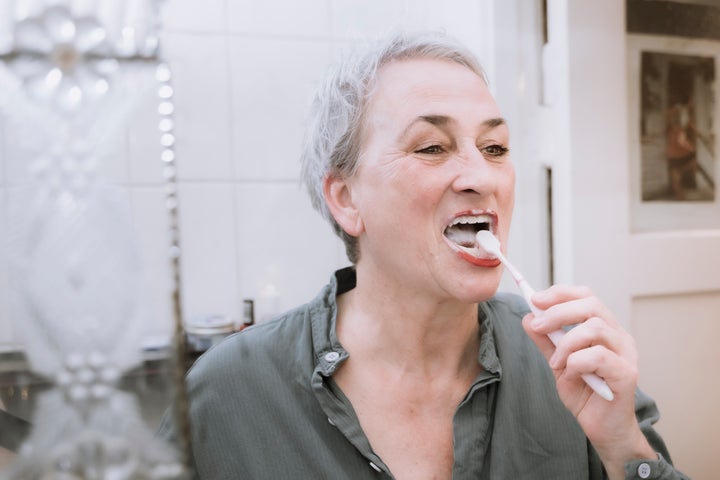
We brush our teeth every single day (well most of us do) – so you would think that we would be experts when it comes to dental hygiene. All you have to do is quickly brush your teeth, give it a rinse, and then you’re good to go, right? Wrong.
There are actually certain things you should and shouldn’t do when you’re brushing your teeth. For example, do you make sure to brush your tongue? Are you brushing your teeth for at least two minutes?
If this all sounds like news to you, don’t worry Payal Bhalla, Lead Dentist and Clinical Director of Quest Dental reveals 6 mistakes you’re making when brushing your teeth.
1. Brushing for too short a time
Everyone should be brushing their teeth for at least two minutes, twice a day. This duration is crucial because it allows enough time to thoroughly clean all surfaces of your teeth, including hard-to-reach areas.
Splitting the two minutes evenly between the upper and lower teeth, as well as
focusing on the front, back, and chewing surfaces, ensures comprehensive cleaning. Using a gentle circular motion and reaching all areas, including the gumline, helps remove plaque, food particles, and bacteria effectively.
It is important to note that two minutes is a general guideline, and some individuals may require more or less time depending on their specific oral health needs.
Brushing your teeth for short periods of time can leave behind harmful substances, increasing the risk of tooth decay, gum disease, and bad breath. Moreover, the recommended duration allows the fluoride in toothpaste to have sufficient contact with your teeth, promoting remineralisation and strengthening of the enamel.
Using an electric toothbrush might make brushing your teeth feel like less of a chore. Electric toothbrushes such as the Philips Sonicare DiamondClean Prestige 9900 can be up to 20 times more effective at removing plaque.
2. Ignoring the tongue
Yes, you do need to brush your tongue. The tongue is a haven for bacteria, food particles, and dead cells, making it a potential breeding ground for bad breath and oral health issues.
Neglecting the tongue during oral hygiene routines can lead to an increased risk of dental problems. Bacteria on the tongue can contribute to plaque formation, tooth decay, and gum disease.
Additionally, neglecting the tongue can hinder the full effectiveness of brushing as it leaves behind a significant source of oral bacteria. Including tongue cleaning as part of your oral hygiene routine by gently brushing or using a tongue scraper helps to remove the buildup of bacteria, promote fresh breath, and contribute to overall oral health and hygiene.
You can use a tongue scraper to get all of the nasty bacteria off your tongue.
3. Brushing too hard
When you brush your teeth vigorously or use excessive force, it can
cause damage to your gums and tooth enamel. The enamel is the protective outer layer of your teeth, and if it wears away, it can lead to tooth sensitivity, cavities, and an increased risk of tooth decay.
Aggressive brushing can also irritate and damage your gums, resulting in gum
recession, gum sensitivity, and even gum disease. Additionally, brushing too hard does not necessarily mean you are cleaning your teeth more effectively.
Using a gentle and circular motion with a soft-bristled toothbrush is recommended to effectively remove plaque and food particles without harming your teeth or gums. It’s important to strike the right balance by
brushing your teeth thoroughly but gently to maintain optimal oral health.
4. Not changing your brush often enough
Forgetting to change your toothbrush can lead to several health risks. Over time, toothbrush bristles become frayed and less effective at removing plaque and food particles from your teeth and gums.
This can result in the accumulation of bacteria, increasing the likelihood of tooth decay, gum disease, and bad breath.
Additionally, an old toothbrush may harbour harmful bacteria and pathogens, posing a risk of infection or illness. It is recommended to replace your toothbrush every three to four months or sooner if the bristles become worn, ensuring optimal oral health and reducing potential hazards.
Ideally you should be changing your tooth brush every three to four months.
5. Brushing your teeth in the same pattern
When brushing your teeth, there are some key motions and patterns that the dentist would advise, this is to ensure you are cleaning every area of the tooth and not missing spots.
If you always brush your teeth in the same pattern every day, for example starting in the upper left and ending at the lower right then there’s a good chance you’re missing areas every day.
To prevent this you should change the pattern in which you brush your teeth. You may have to start focusing on your brushing, but this will ensure that the teeth are being cleaned properly and no areas are missing out.